What are soybean aphids?
Soybean aphids (Aphis glycines) are an invasive pest from Asia that can significantly stunt plant growth and impact yield. First identified in Wisconsin in 2000, soybean aphids are agricultural pests that feed on the sap of soybean plants.
What do soybean aphids look like?
Soybean aphids have pear-shaped bodies that are green to yellow in color and reach up to 1/16-inch long at maturity.
They can be winged or wingless depending on the time of year. Both winged and wingless aphids have two dark cornicles (“tail pipes”). Winged aphids have a darker head and thorax.
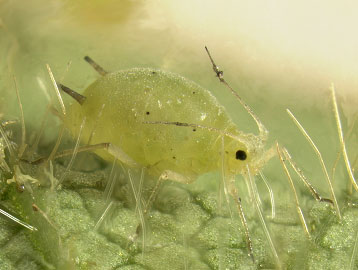
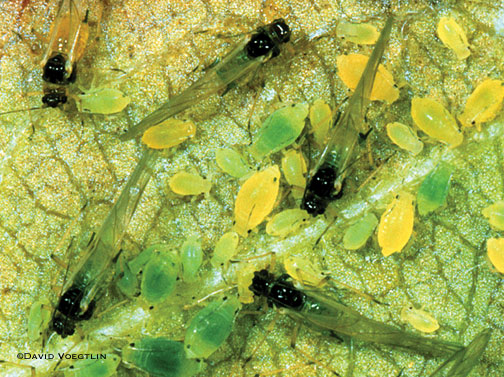
What are the life cycle and biology of soybean aphids?
The soybean aphid life cycle is complex and includes numerous generations and habitats.
Soybean aphids overwinter as eggs on a common invasive shrub called buckthorn. Eggs hatch in the spring and multiple generations of offspring are reproduced asexually. In mid to late June, winged aphids are produced on buckthorn and make their way to soybean crops. Winged aphids may be carried by storm systems, allowing them fly long distances. Numerous generations of aphids are produced during the summer months in soybean fields. In the fall, aphids return to the buckthorn to mate, lay eggs, and overwinter.
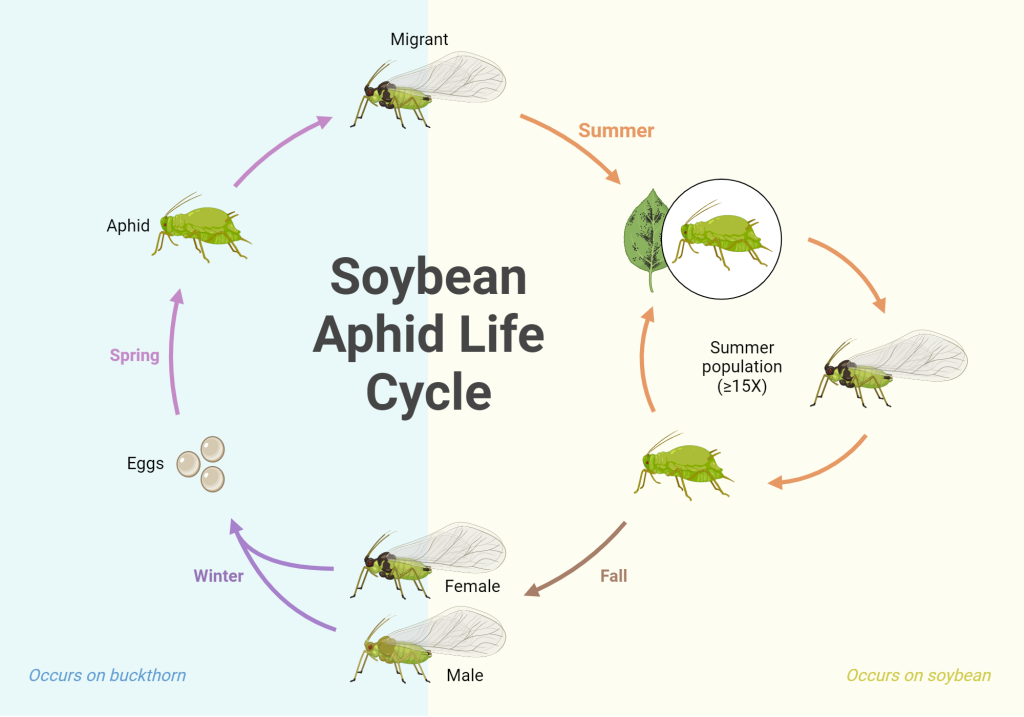
What are the symptoms of soybean aphid damage?
Aphids feed on the sap of plants, leaving behind a sticky, sugary residue called “honeydew”. The honeydew of soybean aphids fosters sooty gray mold which gives the soybean leaves a charcoal-colored tint.
When soybean aphid infestations are severe, feeding stunts plant growth, seed development, and overall yield. Because they are able to fly from plant to plant, soybean aphids also transmit soybean viruses. They prefer feeding on younger plant tissue, so late planted crops (early June) are more affected than early planted crops (late April to early May).
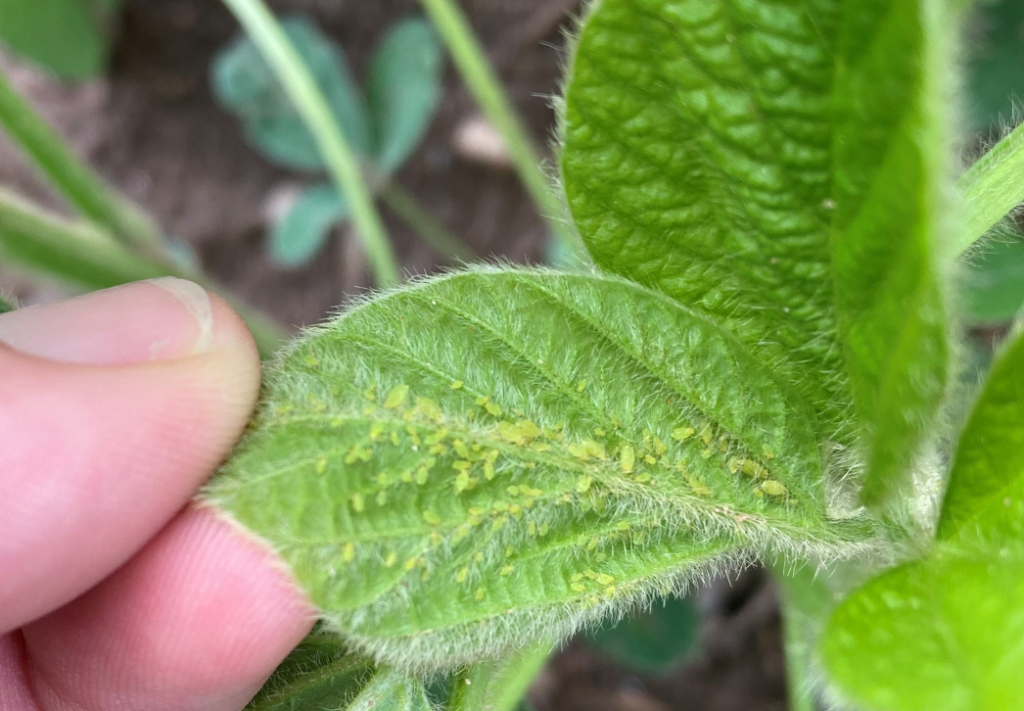
How do you scout for soybean aphids?
Soybean aphids can be found on the underside of leaves and on stems when their population is high.
Start scouting in mid to late June and continue monitoring soybean aphid populations once or twice a week throughout the season as numbers grow. Scouting should continue until aphid populations begin to decline in mid to late August.
Examine 20 to 30 plants around the field and record the number of aphids found. A visual guide for soybean aphid scouting is available here.
What is the threshold to reach for soybean aphid treatment?
Consider treatment for soybean aphids if 80% of the plants are infested with an average of 250 aphids per plant and aphid populations are actively increasing.
Treatment should be considered for R1 to R5 plants. Economic benefit from insecticide applications in vegetative stages or R6 to R8 growth stages is unlikely.
Integrated pest management (IPM) strategies for soybean aphids
Cultural Control: When planting new alfalfa stands, remember to choose varieties that are more aphid pest-resistant. Additionally, in-field weed management is critical, as soybean aphid populations can build up in non-crop plants.
Biological Control: Lady beetles, green lacewings, and pirate bugs feed on aphids. They are effective at controlling aphids until populations reach around 100 per plant. Parasitoid wasps (Hymenoptera: Braconidae) also prey on soybean aphids by laying their eggs into them, which hatch and kill the aphid. This leaves behind aphid mummies which are useful to determine the presence of the wasps.
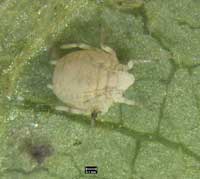
Chemical Control: Refer to A3646: Pest Management in Wisconsin Field Crops for soybean aphid insecticide recommendations in soybeans (pg. 131-132). Insecticide should only be applied to R1-R5 plants when populations are significant. If insecticides are applied when aphid populations are low, beneficial insects will be killed, leaving crops vulnerable to a more severe aphid infestation.
Soybean aphid response and management options
Monitor weather conditions and crop growth stage to determine optimal timing for harvesting or insecticide applications, as needed.
Always apply insecticides according to label instructions and consider factors such as application method, rate, and pre-harvest intervals.
Consider alternative management practices in severely infested fields.
Environmental and ecological considerations for soybean aphid treatment
Minimize pesticide use whenever possible to reduce potential impacts on non-target organisms, biological control organisms, and environmental health.
Implement IPM practices that promote biological diversity and ecosystem resilience.
References
Additional resources
For assistance with soybean aphid management and other agricultural pest issues, contact your local agricultural extension office or entomology expert.


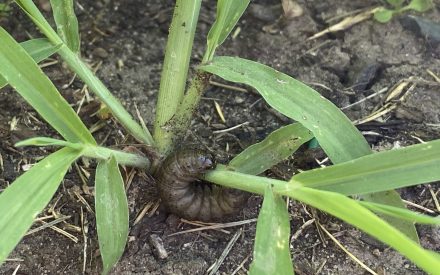 Managing Black Cutworm in Wisconsin Corn Fields
Managing Black Cutworm in Wisconsin Corn Fields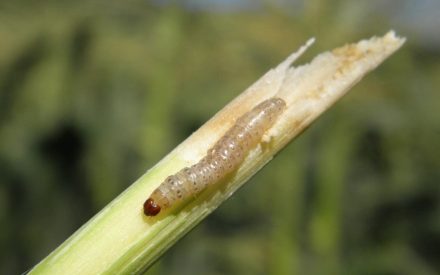 Managing European Corn Borer in Wisconsin Corn Fields
Managing European Corn Borer in Wisconsin Corn Fields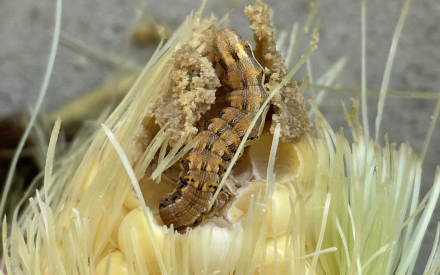 Managing Corn Earworm in Wisconsin Corn Fields
Managing Corn Earworm in Wisconsin Corn Fields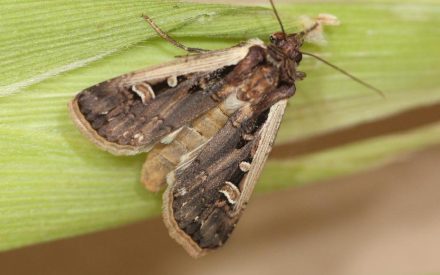 Managing Western Bean Cutworms in Wisconsin Corn Fields
Managing Western Bean Cutworms in Wisconsin Corn Fields


